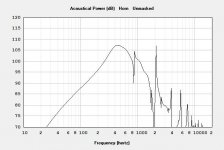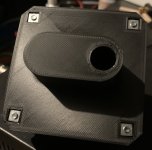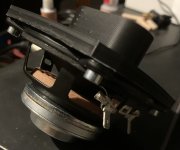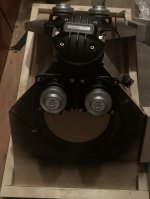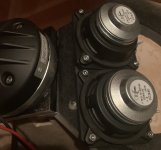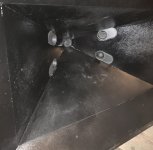David McBean is a genius and Hornresp is the best thing since sliced bread! Playing with the simulations, I came to two conclusions:
1) a better cone volume filler is necessary to reduce the volume to absolute minimum. This will need a few test prints to get as close to the cone as possible. Increasing the volume in front of the cone moves down the bandpass frequency (expected). Might get a few extra Hz.
2) When I unmasked the resonances, I got my dip! The lenght of the back chamber is not 20 cm (as in simulation) and the volume is also less, but I guess the dip comes from reflections in the back cover.
I need to verify this experimentally tomorrow and will run the woofers without the cover as I planned (had to do some other things today, so I just fired up Hornresp for a few minutes).
1) a better cone volume filler is necessary to reduce the volume to absolute minimum. This will need a few test prints to get as close to the cone as possible. Increasing the volume in front of the cone moves down the bandpass frequency (expected). Might get a few extra Hz.
2) When I unmasked the resonances, I got my dip! The lenght of the back chamber is not 20 cm (as in simulation) and the volume is also less, but I guess the dip comes from reflections in the back cover.
I need to verify this experimentally tomorrow and will run the woofers without the cover as I planned (had to do some other things today, so I just fired up Hornresp for a few minutes).
Attachments
Hi pelanj, following this post with interest because my understanding is reducing cone volume filler is about raising the high end of the cone's response.
Never heard anyone say there's any effect that lowers the bandwidth corner (haven't noticed it yet either, but honestly haven't even looked for it, checked for it)
Never heard anyone say there's any effect that lowers the bandwidth corner (haven't noticed it yet either, but honestly haven't even looked for it, checked for it)
There is a balance between the port length and volume under the cone that can be used to tweak the response up. A shorter port helps, so frustrumizing the port holes reduces the length of the port and adds some cone volume.
A resonance at that frequency from the rear chamber could be helped with some damping, sticking a layer of the automotive type felt inside the back chamber if it will fit.
A resonance at that frequency from the rear chamber could be helped with some damping, sticking a layer of the automotive type felt inside the back chamber if it will fit.
Reducing cone volume filler increases the volume of the throat chamber (VTC), increasing VTC lowers the acoustical band pass frequency, and the response peak that occurs just below...my understanding is reducing cone volume filler is about raising the high end of the cone's response.
Although the least VTC will result in the widest bandwidth, I'd not reduce it less than Xlim/Xmech (usually about double Xmax) to avoid any potential contact of the cone with the filler plug on voltage peaks.
Hi pelanj, following this post with interest because my understanding is reducing cone volume filler is about raising the high end of the cone's response.
Never heard anyone say there's any effect that lowers the bandwidth corner (haven't noticed it yet either, but honestly haven't even looked for it, checked for it)
I measured this effect: https://www.diyaudio.com/forums/multi-way/335062-bm-d446-ph-4220-a.html#post5771061
Reducing cone volume filler increases the volume of the throat chamber (VTC), increasing VTC lowers the acoustical band pass frequency, and the response peak that occurs just below.
Yeah, IIRC Tom used a popular high QT 'full range' driver on the Unity prototype presumably so he could just bolt the driver to the horn, so sometimes wonder why all the fancy Synergy effort for typically low power HIFI/HT apps.
So the dip definitely comes mostly from the back cover. For 300 Hz crossover, I can run the woofers with open back for now. The smaller port insert decreases the efficiency a little and extends the HF a little. Different volume filler might help a bit more even though the volume cannot be reduced by much. I wonder if some of the dips are caused by the placement of the hole relatively to the cone - on the edge instead of the middle.
Well, there's definitely an eigenmode between parallel surfaces and multiple ones between parallel and curved and why Altec put felt pads on the inside of compression driver rear covers.
Reducing cone volume filler increases the volume of the throat chamber (VTC), increasing VTC lowers the acoustical band pass frequency, and the response peak that occurs just below.
Although the least VTC will result in the widest bandwidth, I'd not reduce it less than Xlim/Xmech (usually about double Xmax) to avoid any potential contact of the cone with the filler plug on voltage peaks.
That matches my understanding of the effect on the high end of the cone's band pass, that reducing VTC with filler, raises the frequency the cone can reach.
I'm also under the impression that reducing VTC makes for an improved acoustic low-pass, presumably by increasing the order of the acoustic low-pass.
Do you see that as correct?
I thought (misread) juhazi was saying he had an extension in the low-end of the cone in post 61. Hence my reply #62. But i see he was just describing the mechanics on the high-end, like us.
I got a crazy idea - replace each 8PE21 with...drumroll...two 3FE22s🙂 The 3D printed adapter with frustrumized port will fit the horn. With a bit of tape, I should be able to measure how much better or worse this will be. Since I aim for 300 Hz crossover, it should work pretty well for home volumes.
Attachments
I have read elsewhere that 3FE22s don't have very good distortion performance, though in a horn this might not matter.
Have you considered some of the smaller Vifa drivers, e.g. TC5/TC6/TC7 series? Some info is available on HiFCompass, Timothy Feleppa's page, etc.
Have you considered some of the smaller Vifa drivers, e.g. TC5/TC6/TC7 series? Some info is available on HiFCompass, Timothy Feleppa's page, etc.
I have too many of them to try another speakers🙂 I have never noticed any distortion problems in any of my measurements. Maybe it is because I am not using them very low.
I'm also under the impression that reducing VTC makes for an improved acoustic low-pass, presumably by increasing the order of the acoustic low-pass.
I believe you mean increasing Vtc as Dan noted in different wording. 😉
While looking for alternatives, I found a very interesting driver - Beyma 3FR30, which is sort of similar to Eminence Alpha 3, but at a very nice price.
I use the ferrite version of the 3FE22 of on a smaller horn but only down to 500 Hz as they start to roll off (horn is quite small) for PA. Interested in your results on a larger horn.
This is what Hornresp says for 4 x 3FE22s:

300 Hz crossover should be no problem. If the adapter fits the horn, I will print 3 more and test.
300 Hz crossover should be no problem. If the adapter fits the horn, I will print 3 more and test.
The mids could be taken a little bit nearer the throat, but this test did not require any wood working. Just a bit of PLA and some gel super glue. I am curious how these will measure once I wire them together.
Attachments
No time for measurements, but a quick listening test sounded promising. The DE500 is far away from the Heil AMT in quality, but still quite good overall. I just dig the point source behavior of a synergy horn.
I am now considering if I actually need a larger 3 way horn. It would be nice to try, but it seems to me that a 55 cm wide horn works nicely with the Paraflex midbass (or another midbass front horn) and that there is no need to have the 90 - 300 Hz band inside the horn. Well, maybe there is, but all in all this looks like a compromise I could gladly accept. Since the 12" paraflex is being painted now, I used an old Peavey 15" bass reflex box. It kind of worked, but at really lower sensitivity and the sound was not that cool. I need to set up this one with the AMT synergy to stereo...
Consider that when W.E. set out to make the best public address [PA] speaker they wound up with a one piece diaphragm 8" three way single driver (755 tri-ax) with an ~ 80 - 12.5 kHz -F6 and arguably still the best performing overall, so yes, a three way Synergy is worth it IME.
- Home
- Loudspeakers
- Multi-Way
- 2 way Synergy inspired by SPL Runt
